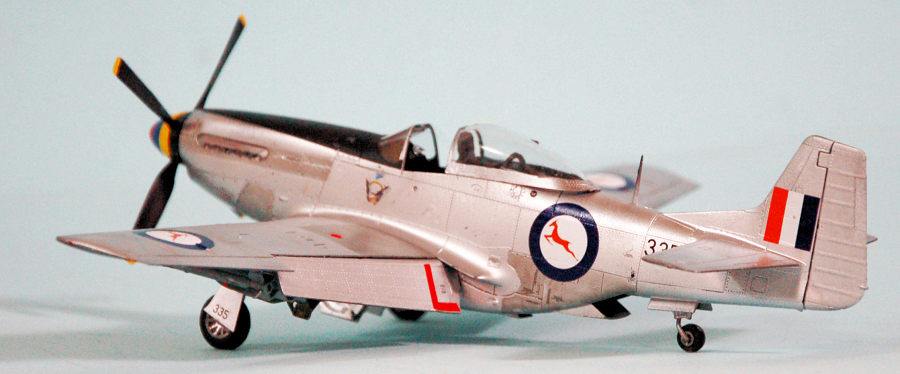
Meng 1/48 P-51D Mustang
| KIT #: | LS-006 |
| PRICE: | $ |
| DECALS: | Two options |
| REVIEWER: | Tom Cleaver |
| NOTES: | Eduard canopy and rockets, Airfix prop and bombs. Xtradecal 48177 - “F-51D Mustang in foreign Service” |

| HISTORY |
Following the outbreak of war in Korea on June 25, 1950, and the UN Security Council resolution of June 26 calling on North Korea to cease its aggression and requesting that UN members come to the defense of South Korea, the South African government decided on August 4, 1950, to commit armed forces to the Korean War.
The decision was taken to send No 2 Squadron, known as “The Flying Cheetahs,” to represent South Africa in the war. The squadron had been formed in the early days of the East African campaign in World War II and served there and in the Western Desert, Sicily and Italy. The task of forming the squadron for overseas service was given to Cmdt S. Theron, DSO, DFC, AFC, a veteran fighter pilot of World War II. A call for volunteers was made by the Director General of the Air Force and the response was overwhelming not only from members of the Permanent Force but from the Citizen Force and ex-members of the SAAF. A decision was made that no aircraft or supporting equipment would be sent from South Africa, but that it would be purchased from the United States and made available to the squadron when it arrived in the Far East.
On 5 September, 49 officers and 157 other ranks reported for duty at AFB Waterkloof A small liaison staff under Cmdt J. D. Pretorius, AFC, left for Japan on 10 September and on 25 September the squadron left for Durban where they set sail for Japan, arriving in Yokohama on 5 November. By now, the situation in Korea had changed radically, with the UN forces poised to “roll back communism” by invading North Korea. The squadron moved to Johnson AFB, where conversion training on to the F-51D Mustang was commenced.
On 8 November the first pilots commenced flight transition training and fared so well that on 12 November it was decided to send an advance ground party and five aircraft to Korea for further operational training. On 16 November this advance party arrived at K-9 Airfield near Pusan. The squadron was attached to 18th Fighter Bomber Wing, with which they would serve for the duration of the war.
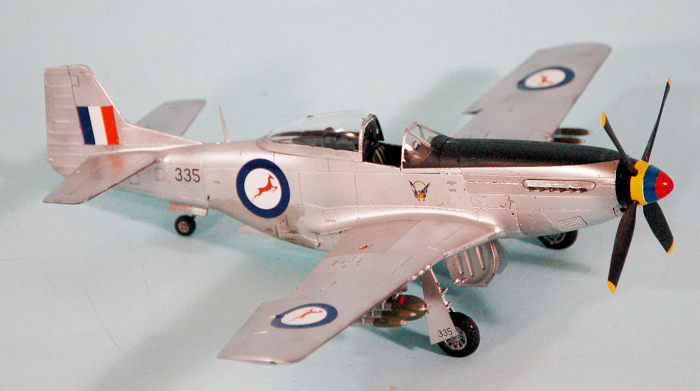 The first
SAAF operation in Korea occurred on 19 November when Cmdt Theron and Capt
Lipawsky took off from K-9 airfield to bomb and strafe Communist supply lines,
the Mustangs landing at K-24 airfield, Pyongyang East Airfield in North Korea.
The remainder of the detachment moved up from K-9 on 20 November and commenced
operations the next day. Conditions at K-24 were primitive, with personnel
living in tents in bitter winter conditions. No transport was available and all
equipment had to be manhandled. The mess hall was an ex-North Korean Air Force
hangar with gaping holes, while the dirt floor was damp and cold. The one short
runway was soft and rough, which made operations very difficult.
The first
SAAF operation in Korea occurred on 19 November when Cmdt Theron and Capt
Lipawsky took off from K-9 airfield to bomb and strafe Communist supply lines,
the Mustangs landing at K-24 airfield, Pyongyang East Airfield in North Korea.
The remainder of the detachment moved up from K-9 on 20 November and commenced
operations the next day. Conditions at K-24 were primitive, with personnel
living in tents in bitter winter conditions. No transport was available and all
equipment had to be manhandled. The mess hall was an ex-North Korean Air Force
hangar with gaping holes, while the dirt floor was damp and cold. The one short
runway was soft and rough, which made operations very difficult.
On 24 November 1950, the Eighth Army Yalu Offensive began with UN forces attacking north from the Chongchon River. The weather by now was so cold that tank engines had to be run throughout the night; when they were ordered to move out in the morning many tankers found their tracks frozen to the ground and could only move after being pushed by another tank. Ice floes were seen in the rivers.
The advance lasted a day. At 2200 hours on 25 November, Second Division soldiers in bivouacs and vehicle parks all along the Chongchon Valley were awakened by a cacophony of bugles, whistles, drums and rattles, followed by gunfire, as Chinese assault units smashed through unprepared perimeters and overran position after position. By dawn on 26 November, Second Division had been driven back two miles down the valley. The UN forces faced 200,000 troops of the Chinese People’s Volunteer Army, formerly the Ninth Army of the People’s Liberation Army. The Chinese intervention in the Korean War would lead to what then-Secretary of State Dean Acheson later called “The worst defeat of American arms since the Second Battle of Bull Run,” and what historian Sir Martin Gilbert later described as “the most thorough defeat of a previously-victorious army in recorded history.”
The morning of 26 November, the Mustangs of the 18th FBW, including 2 Squadron, were called to support the stunned ground forces. However, the enemy was so well-camouflaged in the forests that it was nearly impossible for air support to find and attack them.
After hard fighting, Second Division was finally able on 28 November to organize its units and commence a retreat to Kunu-ri. Chinese units were already attacking positions south of the line of retreat, since they had flowed through the UN lines to block retreat. The division was ordered to continue directly south to Sunchon. To this point, the Chinese had allowed American units to escape once overrun. Colonel Paul Freeman, commander of the 23rd Regimental Combat Team which became the rearguard of the retreat, later saw the initial attacks as having been a test of American strength and will. “They came tongue in cheek at first, to see what we would do. Then they found what a thin line we had, how easily the South Koreans cracked. They saw what a pushover we were. Then they became very aggressive, very bold - and stayed that way.”
At 0130 hours on 30 November, with the defensive perimeter at Kunu-ri shrinking under assault, Second Division was ordered to move out and run the road south to Sunchon. The vehicle convoy soon became a nose-to-tail traffic jam on the narrow six-mile road as they ran into a storm of machine-gun and mortar fire from the high hills of the pass to either side. Trucks keeled over and caught fire as men ran for their lives. Tanks blew up when hit by bazookas the Chinese captured from the Americans. Overloaded jeeps roared down the road, careening into the ditches as their drivers were killed. “The Death Ride From Kunu-ri,” as the event was later recalled by the survivors, was among the grimmest events in the history of the U.S. Army.
Vehicles sought to smash their way through the blazing wreckage of those hit before while a deathly paralysis of command and discipline overtook the division. Survivors later reported passing men who sat motionless in their vehicles, overcome by the force of the attack and unable even to rouse themselves to return fire as they waited for death. The mortaring and machine-gun fire continued throughout the night as Chinese troops came down out of the hills and soon there was desperate hand-to-hand fighting as the Americans realized the enemy intended to kill them all. Some men escaped in small groups by taking to the hills, though many become prisoners. The majority of UN POWs held by the Communists through the war were captured during this retreat.
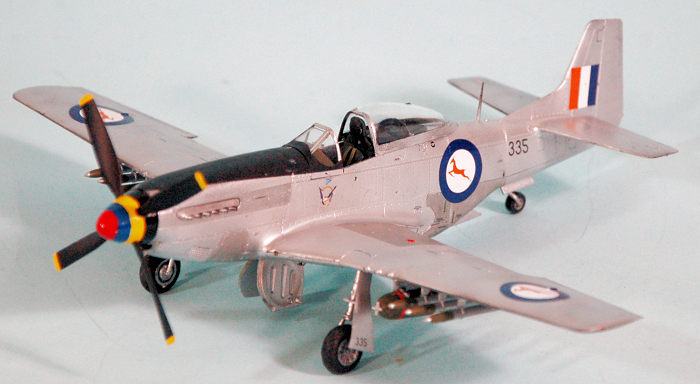 Even the
coming of daylight and American fighter-bombers did not save things as the
survivors crawled out of the pass. In the one afternoon and evening of 29
November and the night of 30 November, Second Division lost 3,000 men and nearly
all its equipment on the road between Kunu-ri and Sunchon. The division fell
apart almost completely during the following days as the retreat became a rout,
and it would be six months before Second Division was considered capable of
re-entering combat. On the morning of 1 December 1950, Colonel Freeman turned to
his Executive Officer and said bitterly, “Look around here. This is a sight that
hasn’t been seen for a hundred years - the men of a whole United States Army
fleeing from a battlefield, abandoning their wounded, running for their lives.”
Freeman’s 23rd RCT would be the only one in the 2nd Division considered
combat-ready at the end of the month.
Even the
coming of daylight and American fighter-bombers did not save things as the
survivors crawled out of the pass. In the one afternoon and evening of 29
November and the night of 30 November, Second Division lost 3,000 men and nearly
all its equipment on the road between Kunu-ri and Sunchon. The division fell
apart almost completely during the following days as the retreat became a rout,
and it would be six months before Second Division was considered capable of
re-entering combat. On the morning of 1 December 1950, Colonel Freeman turned to
his Executive Officer and said bitterly, “Look around here. This is a sight that
hasn’t been seen for a hundred years - the men of a whole United States Army
fleeing from a battlefield, abandoning their wounded, running for their lives.”
Freeman’s 23rd RCT would be the only one in the 2nd Division considered
combat-ready at the end of the month.
During all this, the Mustang pilots flew 2-3 missions a day, with their ground crews refueling and rearming the aircraft in the open at Pyongyang East, as the biggest Siberian blizzard to hit North Korea in 144 years brought daytime temperatures down to 10 degrees below zero Fahrenheit, while snow storms made flying difficult.
On the road south from Sunchon to Pyongyang, panic spread throughout the Eighth Army. Major John Willoughby of the 1st Middlesex of the British 27 Brigade was shocked to attend a briefing at which his American counterpart warned, “Remember, if you see a red Verey light, just get everybody you can together and head south.” On December 1, the vast supply dumps at Pyongyang were set afire to prevent their capture by the enemy. Between 25 November and 2 December 1950, the Eighth Army took 11,000 casualties, killed, wounded and missing.
The night of December 1, the decision was made to evacuate Pyongyang. The Mustangs at Pyongyang East were fueled and armed for takeoff at first light on December 2. Once the aircraft were in the air, the ground crews set fire to everything on the field that could not be taken in the trucks, and the men joined the line of refugees in what would turn out to be the longest retreat in the history of the US Army, 109 miles to Seoul, hoping to hold the enemy at the Han River. What was later remembered by the survivors as “The Big Bug Out,” saw U.S. units retreating so far, so fast, that they outran their pursuers. This was a good thing, since the units were in no shape physically or mentally to stand and fight.
An officer of the 8th Royal Irish Hussars wrote of the retreat from Pyongyang, “The march out of Pyongyang will be remembered mainly for the intense cold, the dust, and the disappointment. Nothing appeared to have been attempted, let alone achieved. Millions of dollars’ worth of valuable equipment had been destroyed without a shot being fired or any attempt made to consider its evacuation. Seldom has a more demoralizing picture been witnessed than the abandonment of this, the American forward base, before an unknown threat of Chinese soldiers - as it transpired, ill-armed and on their feet or on horses.”
The ground crews finally reached K-13, Suwon Air Base, 60 miles south of Seoul, on December 4. The Mustangs of the 18th and 35th Fighter Bomber Wings were joined on the field by F-80s of the 8th and 51st wings, to provide air cover for the UN forces along the Han River. The most important contribution of American air power at the end of 1950 was the interdiction of enemy supply routes, which prevented the Chinese from converting battlefield superiority into full-scale destruction and defeat of the UN forces.
On 5 December. 2 Squadron lost its first Mustang when rockets fired by Capt Davis struck a railway truck loaded with explosives which blew up with a terrific explosion and Capt Davis was temporarily knocked unconscious. His aircraft had been severely damaged and he was forced to crash land. His wingman, Capt Lipawsky, called for rescue. A US L-5 Sentinel arrived and the pilot landed on a narrow road adjacent to the crashed Mustang. The observer, Capt Millet, gave up his seat to Capt Davis. This was an outstanding act of bravery as the area was surrounded by enemy troops. When the L-5 returned. Capt Millet had disappeared. Capt Lawrence later returned and just before dark found and rescued Capt Millet.
 The Chinese
were now the victims of extended supply lines. Senior staff member to Marshal
Peng Duhai Hu Seng later wrote, “While we wished to continue to push the enemy,
we could not open our mouth too wide. China was unprepared for the new military
situation created by the deep advance. We were now in a position where we could
not continue to reinforce our army in Korea, because we could not supply more
men.” By early December, the People’s Volunteer Army was not the force it had
been when the offensive had begun on the Chongchon River. Over the course of the
offensive, the PVA had suffered 40 percent casualties, with more to frostbite
and starvation than to battle. The Chinese offensive exhausted its momentum by
the end of the year, though Seoul would fall to the communists a second time
just after the New Year before the advance ran completely out of steam.
The Chinese
were now the victims of extended supply lines. Senior staff member to Marshal
Peng Duhai Hu Seng later wrote, “While we wished to continue to push the enemy,
we could not open our mouth too wide. China was unprepared for the new military
situation created by the deep advance. We were now in a position where we could
not continue to reinforce our army in Korea, because we could not supply more
men.” By early December, the People’s Volunteer Army was not the force it had
been when the offensive had begun on the Chongchon River. Over the course of the
offensive, the PVA had suffered 40 percent casualties, with more to frostbite
and starvation than to battle. The Chinese offensive exhausted its momentum by
the end of the year, though Seoul would fall to the communists a second time
just after the New Year before the advance ran completely out of steam.
The first three months of 1951 saw nearly unremitting combat for the fighter-bombers as the UN ground forces attempted to hold the Chinese and then to push back. The Mustang was not the best airplane for battlefield air support, since its liquid-cooled engine and radiator were vulnerable to ground fire. American and French units stopped the Chinese in the Battle of Chipyong-ni between 13-15 February, later called “The Gettysburg of the Korean War,” since it marked the high water line of the Chinese advance into South Korea.
On 2 February Lieutenant W. F. Wilson was hit by small arms fire and bailed out over the sea only to disappear, while on 7 February Lieutenant D. R. Leah was killed when his aircraft was seen to strike the ground while strafing enemy vehicles on the road south of Yonhung. On 15 February Lieutenant Doveton’s F-51 was shot down by ground fire while he was strafing enemy positions in the Kaesong area and he was killed. On 27 February the outstanding work which had been carried out by the squadron under the most difficult conditions was acknowledged when Cmdt S. v. B. Theron and Captains J. F. O. Davis, H. O. M. Odendaal, G. B. Lipawsky and W. J. J. Badenhorst were awarded American Distinguished Flying Crosses.
2 Squadron would continue to fly battlefield close air support in Mustangs until early 1953, when they and the rest of the 18th Fighter Bomber Wing were re-equipped with F-86F fighter-bombers. During the war, 2 Squadron flew 12,067 sorties of which 10,373 had been flown on Mustangs and 1,694 on Sabres. The cost had been high as 74 out of 95 Mustangs had been lost as well as 4 Sabres. The price in lives was also high as altogether 34 pilots and two ground crew were killed, while eight pilots held as prisoners of war were returned by the Communists in August 1953.
| THE KIT |
Meng released their P-51D some two years ago. The model is advertised as having a snap-tite glue-free assembly. While this is indeed the case, the model is best assembled with glue for a more permanent construction.
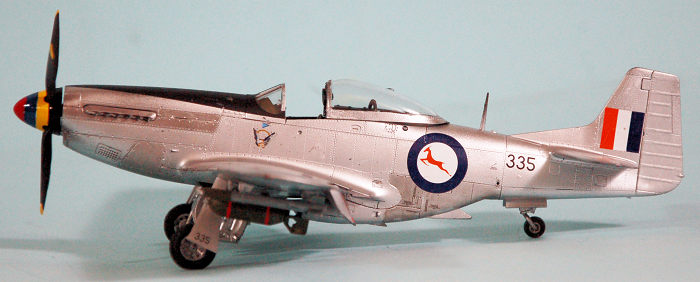 The kit
provides both the cuffed Hamilton-Standard propeller and the uncuffed
Aeroproducts prop, allowing a modeler to create a P-51D or P-51K. As a P-51D,
the model represents a P-51D-15 or later Mustang. Both the US metal 75-gallon
drop tanks and the paper 108-gallon tanks used in the ETO are provided. There
are no other underwing stores. The kit provides both the “Los Angeles” and
“Dallas” sliding canopies. These are a bit thick and will have to be modified to
sit properly in the open position.
The kit
provides both the cuffed Hamilton-Standard propeller and the uncuffed
Aeroproducts prop, allowing a modeler to create a P-51D or P-51K. As a P-51D,
the model represents a P-51D-15 or later Mustang. Both the US metal 75-gallon
drop tanks and the paper 108-gallon tanks used in the ETO are provided. There
are no other underwing stores. The kit provides both the “Los Angeles” and
“Dallas” sliding canopies. These are a bit thick and will have to be modified to
sit properly in the open position.
Surface detail includes panel lines and rivets. While these are heavier than the surface detail found in the new Eduard kit, they are not so bad that the proverbial “coat of paint” will not diminish them.
Decals are provided in this release for the P-51D “American Beauty” of the 308th Fighter Squadron 31st Fighter Group of the 15th Air Force flown by Captain John Voll, leading ace of the group, and for the P-51D “Short-Fuse Sallee,” flown by Captain Richard E. Turner of the 356th Fighter Squadron of the 354th “Pioneer Mustangs” Fighter Group. The decals are of excellent quality and include stenciling.
| CONSTRUCTION |
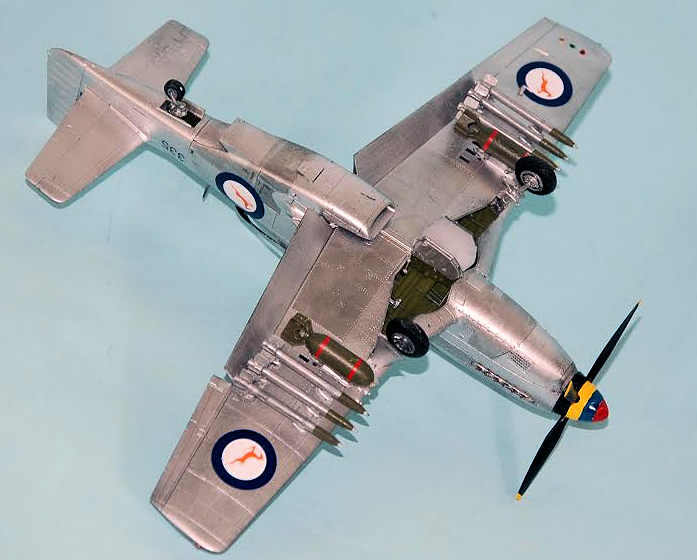 Construction of this model is considerably different from the more normal kit,
due to the “positive attachment” of the “glue-free” design. This can involve
some industrial-strength pushing and shoving to get the parts into position, but
they snap into position in the end, and it is impossible to fit them wrong. This
is a good thing for those modelers who are “Mustang gear challeneged” regarding
the proper placement of the main gear.
Construction of this model is considerably different from the more normal kit,
due to the “positive attachment” of the “glue-free” design. This can involve
some industrial-strength pushing and shoving to get the parts into position, but
they snap into position in the end, and it is impossible to fit them wrong. This
is a good thing for those modelers who are “Mustang gear challeneged” regarding
the proper placement of the main gear.
Since I hadn’t built a model like this before, I decided to commit the radical act of following the instructions as regards the assembly sequence. This turned out to be a good thing, since there were a couple places where I thought to skip ahead and use my experience in determining what to do, only to discover that one almost cannot assemble the kit out of sequence without causing major fit troubles later on.
I had decided from the outset that I didn’t want to try to fill all that surface detail on the wings, which led me to decide to do a Korean War Mustang, since quite a few of those F-51Ds had the putty and lacquer stripped from their wings. The decision was aided by the fact that the interior detail of the cockpit is not as good as either the Airfix or Eduard kits, and thus painting it black would cover the lack of detail. I did, however, scratchbuild a throttle quadrant from Evergreen stock, since what is in the kit is really deficient.
My decision to make a Korean War airplane allowed me to use the uncuffed Hamilton-Standard prop provided in the Airfix F-51D kit, as well as the 500-pound bombs from the Airfix kit. I decided to use the underwing rockets from the Eduard kit, and drilled out holes in the lower wing to mount them. In researching the airplane I was going to do, I saw that it had the “Dallas” canopy. After determining that the kit canopy is pretty thick and needs to be scraped around its lower edge to allow it to sit right, I decided to use the Dallas canopy left over in the Eduard kit, since it is thin and fit correctly without any modification.
I assembled the cockpit sides and the floor with seat and fuel tank, then airbrushed everything with Tamiya “NATO Black,” after which I picked out detail with a white and a silver artist’s pencils. I used the instrument panel decal provided in the kit.
I then assembled the fuselage. Meng has a very interesting kit design, with the upper engine cowling, the rear upper fuselage aft of the cockpit ahead of the vertical fin, the lower cowling and the rear lower fuselage as separate pieces, done on panel lines, which when assembled solves the problem of a centerline seam to fill, since it isn’t there. The air scoop is also ingeniously designed with the parts separated on panel lines to avoid that seam there, too. The rear wheel well fits to the lower rear fuselage part before further assembly and requires that you attach the tailwheel leg at this point.
 Meng’s kit
was the first P-51 kit to get the main gear well correct, with the well
extending inside to the main spar. This part is not as well detailed as either
the Airfix or Eduard kits, which also accomplish this, but it looks good enough
when placed in the wing. The assembly requires you to attach the main gear legs
at this point, since they have long tangs that slip inside the wing to the rear
of the wheel well, holding the gear leg at the proper angle and giving it a lot
of strength; one is unlikely to be breaking this gear off accidentally. The
assembly also requires you to attach the dropped flaps to the upper wing half
before proceeding with the assembly of the lower wing and upper wing parts. I
attached the ailerons and let things set up.
Meng’s kit
was the first P-51 kit to get the main gear well correct, with the well
extending inside to the main spar. This part is not as well detailed as either
the Airfix or Eduard kits, which also accomplish this, but it looks good enough
when placed in the wing. The assembly requires you to attach the main gear legs
at this point, since they have long tangs that slip inside the wing to the rear
of the wheel well, holding the gear leg at the proper angle and giving it a lot
of strength; one is unlikely to be breaking this gear off accidentally. The
assembly also requires you to attach the dropped flaps to the upper wing half
before proceeding with the assembly of the lower wing and upper wing parts. I
attached the ailerons and let things set up.
Attaching the wing sub-assembly to the fuselage sub-assembly is very easy, and the two fit together tight. I didn’t need to use any filler anywhere in this project. I then attached the lower cowling, which includes the lower wing area ahead of the gear well, and finished off by attaching the horizontal stabilizers.
| COLORS & MARKINGS |
I gave the model an overall coat of thinned Tamiya X-18 “Semi-Gloss Black” as a primer coat for the Vallejo metallic paints. I masked off the anti-glare panel; the color photos I had of the airplane I was modeling show it had the post-war black panel.
I shot an
overall coat of Vallejo Aluminum. Once that was dry, I brush-painted the area of
the cowling around the exhaust, the wing fuel tanks and the area of the scoop
around the radiator with Vallejo Duraluminum, p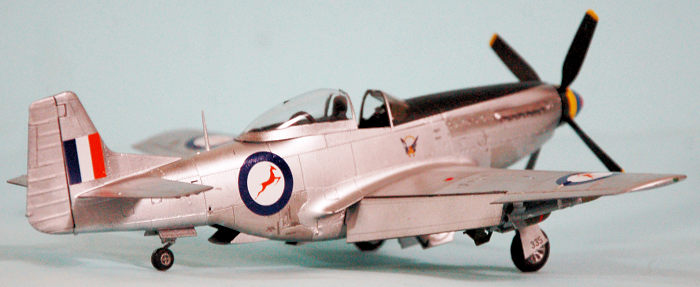 ainted the rudder with Vallejo
White Aluminum, then did a few other panels with a 50-50 mixture of White
Aluminum and Duraluminum. The really nice thing about Vallejo metallic paints is
that once the base coat is applied with an air brush and dry, you can brush
paint other panels and not have any brush marks in the paint. This way you don’t
have to risk pulling up any of this thin paint masking off with tape.
ainted the rudder with Vallejo
White Aluminum, then did a few other panels with a 50-50 mixture of White
Aluminum and Duraluminum. The really nice thing about Vallejo metallic paints is
that once the base coat is applied with an air brush and dry, you can brush
paint other panels and not have any brush marks in the paint. This way you don’t
have to risk pulling up any of this thin paint masking off with tape.
I painted the spinner gloss white, then scored the areas of the stripes with a #11 blade and carefully hand-painted the yellow, blue and red colors with a 0000 brush. The prop and back plate were left black as I had airbrushed them. When done, I unmasked the anti-glare panel and the windshield and canopy.
I had long wanted to do an SAAF F-51d, and the Xtradecal sheet 48177, “F-51D Mustangs in Foreign Service” has the plane flown by Commandant Theron during “The Big Bug Out.” As usual, the decals went on without problem under a coat of Solvaset.
I attached the wheels, the exhausts, and the underwing ordnance. I fitted the canopy in the open position.
| CONCLUSIONS |
Overall, I have to rank the Meng kit as number three behind the Eduard and Airfix kits, which are in a close tie in which cost is the deciding factor for a modeler in deciding which is #1 and #2. All three kits are very close in ranking, with the Meng ending up in third place due to it being nearly twice as expensive as the Airfix kit, and even more expensive than the new Eduard kit, while not providing details in similar quality to those kits.
That said, this kit makes up into a very nice model, and I highly recommend it to a modeler new to the hobby who wants to take a step up to a more complicated kit with the assurance that the assembled model will look good, due to the positive alignment fit design. This feature is also useful for a modeler who is returning to the hobby and needs assurance that it is indeed “like riding a bicycle.” Anyone who builds this kit will no longer have an excuse for not getting the main gear alignment correct when building an Airfix or Eduard kit, since this completed model will be a guide to getting it right on the others. I particularly liked the way the fuselage was designed to get rid of those pesky centerline seams.
Recommended for anyone from newbie to grizzled veteran. Another nice P-15D kit.
| REFERENCES |
Historical section adapted from “MiG Alley: The U.S. Air Force in Korea 1950-53" available soon.
19 September 2019
Copyright ModelingMadness.com Review kit courtesy of Dan Lee If you would like your product reviewed fairly and
fairly quickly, please
contact
the editor or see other details in the
Note to
Contributors. Back to the Main Page
Back to the Review
Index Page
Back to the Previews Index Page